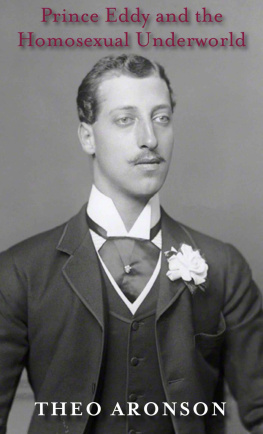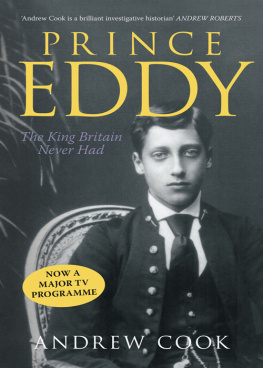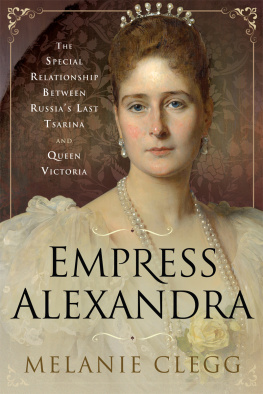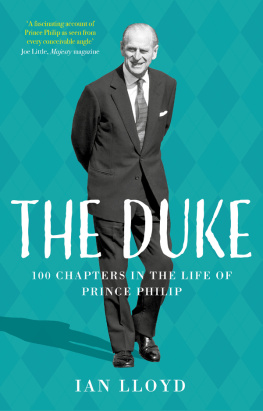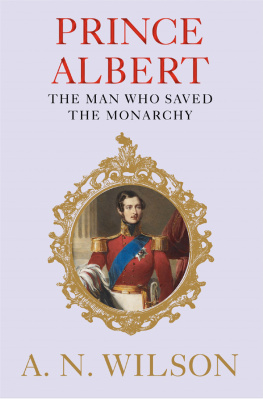Prince Duke of Clarence and Avondale Albert Victor - Prince Eddy and the Homosexual Underworld
Here you can read online Prince Duke of Clarence and Avondale Albert Victor - Prince Eddy and the Homosexual Underworld full text of the book (entire story) in english for free. Download pdf and epub, get meaning, cover and reviews about this ebook. City: New York;Great Britain, year: 1995;2013, publisher: Thistle Publishing;Barnes & Noble, genre: Non-fiction. Description of the work, (preface) as well as reviews are available. Best literature library LitArk.com created for fans of good reading and offers a wide selection of genres:
Romance novel
Science fiction
Adventure
Detective
Science
History
Home and family
Prose
Art
Politics
Computer
Non-fiction
Religion
Business
Children
Humor
Choose a favorite category and find really read worthwhile books. Enjoy immersion in the world of imagination, feel the emotions of the characters or learn something new for yourself, make an fascinating discovery.
- Book:Prince Eddy and the Homosexual Underworld
- Author:
- Publisher:Thistle Publishing;Barnes & Noble
- Genre:
- Year:1995;2013
- City:New York;Great Britain
- Rating:4 / 5
- Favourites:Add to favourites
- Your mark:
- 80
- 1
- 2
- 3
- 4
- 5
Prince Eddy and the Homosexual Underworld: summary, description and annotation
We offer to read an annotation, description, summary or preface (depends on what the author of the book "Prince Eddy and the Homosexual Underworld" wrote himself). If you haven't found the necessary information about the book — write in the comments, we will try to find it.
Prince Eddy and the Homosexual Underworld — read online for free the complete book (whole text) full work
Below is the text of the book, divided by pages. System saving the place of the last page read, allows you to conveniently read the book "Prince Eddy and the Homosexual Underworld" online for free, without having to search again every time where you left off. Put a bookmark, and you can go to the page where you finished reading at any time.
Font size:
Interval:
Bookmark:
Prince Eddy and the Homosexual Underworld
Theo Aronson
Copyright 2013, Theo Aronson
All Rights Reserved
This edition published in 2013 by:
Thistle Publishing
36 Great Smith Street
London
SW1P 3BU
For
Aedwyn Darroll
Plates 1, 8, 9, 10, 11, 12, 14, 19, 21, 22 and 23, Authors Collection; 2, 3, 4, 5, 6, 16, 17 and 18, The Illustrated Police News; 7, The Royal Archives Her Majesty the Queen; 13, from J.K. Stephen, Lapsus Calami; 15, J.D. Reese, The Duke of Clarence and Avondale in Southern India; 20, Hugo Vickers.
I have not set out to write a conventional biography of Prince Albert Victor, Duke of Clarence and Avondale. The destruction of all his papers (for reasons which will become apparent on reading this book) would, in any case, have made this impossible. Rather, I have explored the central mystery of his life: his sexual orientation. For the Princes name has been linked to one of the greatest sexual scandals of the period. The uncovering of a homosexual brothel in Londons Cleveland Street led, in turn, to an extraordinary cover-up on the part of the government; a cover-up which is explicable only in the light of the Princes involvement in the scandal.
At the same time, and in order to put the affair into perspective, I have painted a picture of the active and colourful homosexual underworld during the last decades of the reign of the Princes grandmother, Queen Victoria.
I am indebted to three main original sources for my material. They are the files of the Director of Public Prosecutions at the Public Record Office, Chancery Lane; the Home Office files at the Public Record Office, Kew; and the Esher papers held at the Archives Centre, Churchill College, Cambridge. I have also been able to consult those two privately printed and circulated studies of the Victorian homosexual underworld held in the British Library: The Sins of the Cities of the Plain by Jack Saul and The Intersexes by Edward I. Stevenson, writing as Xavier Mayne. For help, to a greater or lesser extent, I must thank, in alphabetical order, Myrtle V. Cooper of the Archives Department, Metropolitan Police Service; Aedwyn Darroll; Alex Hooper of the Falmouth Art Gallery; R.R. Milne, Sub-Librarian of Trinity College Library, Cambridge; Stephen Mitchell; S.G. Roberts of the Royal Commission on Historical Manuscripts; Barry Rose of the Criminologist; Martin Taylor of the Churchill Archives Centre, Churchill College, Cambridge; Hugo Vickers; A. Williams of the Public Record Office; Colin Wilson. I am grateful to the staffs of the Public Record Office at Chancery Lane and Kew, the British Library and the Newspaper Library at Colindale, the Bristol Reference Library, the Bath Reference Library and, most particularly, the Frome Library. Two books that have proved useful are The Cleveland Street Affair by Lewis Chester, David Leitch and Colin Simpson, and The Cleveland Street Scandal by H. Montgomery Hyde.
As always, my greatest debt is to Brian Roberts for his unfailing interest and support.
In November 1970 an article in a relatively obscure British journal unleashed a flood of international speculation. The article concerned the notorious Victorian mass-murderer, Jack the Ripper. Writing in the Criminologist, a Dr T.E.A. Stowell claimed to know the Rippers identity. Although there has never been any shortage of Ripper suspects, what made Stowells claim especially remarkable was the status of his subject. Without actually giving a name, he supplied enough information to make his candidates identity abundantly clear. It was none other than Queen Victorias grandson, Prince Albert Victor, Duke of Clarence and Avondale. As Heir Presumptive to the British throne and future King-Emperor, the Prince had been destined to occupy what the Queen blandly described as the greatest position there is.
The eighty-five-year-old Dr Stowell had been convinced of Prince Albert Victors guilt for over half a century. He had kept the evidence to himself, he said, for fear of involving, as witnesses, some close friends who had still been alive.Princes syphilis; indeed his death, at the age of twenty-eight in 1892, had been due not, as was generally believed, to pneumonia but to a syphilitic softening of the brain. This information came, Stowell assured Wilson, from his reading of the private papers of Queen Victorias physician, Sir William Gull.
In his twelve-page article Jack the Ripper A Solution?, published in the Criminologist in November 1970, Dr Stowell was less frank than he had been with Colin Wilson. Instead of referring to Prince Albert Victor by name, he called his suspect S. Although Stowell is wrong on several minor points, there can be no doubt that S was Prince Albert Victor.
Stowells sensational insinuation that Jack the Ripper had been Queen Victorias grandson, the great-uncle of Queen Elizabeth II was eagerly taken up by press, radio and television. But at this point Stowell began to back-track. Interviewed on television, he refused to confirm or deny that the Prince had been the Ripper. On 4 November an entry in The Times Diary claimed that Buckingham Palace regarded this mischievous calumny as too ridiculous for comment. It went on to quote evidence from a loyalist on the staff of Buckingham Palace which proved that the Prince had been in Scotland at the time of two of the murders.
Apparently taking fright, Stowell promptly wrote to The Times to deny that he had ever implied that Prince Albert Victor was the mass-murderer. He signed his letter as a loyalist and a royalist.
And then, on 8 November 1970 by one of lifes extraordinary twists Dr Stowell suddenly died. Just over a week had passed since the publication of his theory. Stowells son, Dr T. Eldon Stowell, interviewed by a clutch of reporters, claimed that all the papers on which his late father had based his extraordinary story had been destroyed immediately after his death. I read just enough to make certain that there was nothing of importance, said Dr Stowell Jr. My family decided that this was the right thing to do. I am not prepared to discuss our grounds for doing so.
By then, however, the story had been taken up by the worlds press. It has been estimated that over 3,000 newspapers and magazines carried reports of Stowells dramatic unmasking of Prince Albert Victor. Suddenly photographs and descriptions of this long-forgotten figure appeared across the globe. The Prince certainly looked suspicious. With his hooded eyes, waxed moustache, elongated face and immaculate clothes, he exuded an odd, mysterious, faintly sinister air. Even allowing for the limitations of late Victorian photography, he had a curiously inanimate look; his gaze was impenetrable.
Although, for a variety of reasons, Stowells theory was subsequently dismissed, rumours about the intriguing figure of Prince Albert Victor continued to spread. Indeed, they became progressively wilder. He was said to have been slow-witted to the point of imbecility. He had led an exceptionally dissipated life, having indulged in unmentionable vices. He had been homosexual. Secretly married, the Prince had fathered an illegitimate child. If he had not actually been Jack the Ripper, he had been closely connected with the murders. Kept for years under close supervision, Prince Albert Victor had died, not at Sandringham, but in a private mental home, from syphilis. He had been poisoned; his fingers and toes had turned suspiciously black after his death. Some claimed that he had not died in 1892 at all but had lived on, locked away in a castle like some latter-day Man in the Iron Mask, until 1933. The fact that all documentation about his life has been destroyed that, in the discreet phraseology of the Royal Archives, his file has not survived merely adds weight to these theories. It renders him even more enigmatic.
Next pageFont size:
Interval:
Bookmark:
Similar books «Prince Eddy and the Homosexual Underworld»
Look at similar books to Prince Eddy and the Homosexual Underworld. We have selected literature similar in name and meaning in the hope of providing readers with more options to find new, interesting, not yet read works.
Discussion, reviews of the book Prince Eddy and the Homosexual Underworld and just readers' own opinions. Leave your comments, write what you think about the work, its meaning or the main characters. Specify what exactly you liked and what you didn't like, and why you think so.

